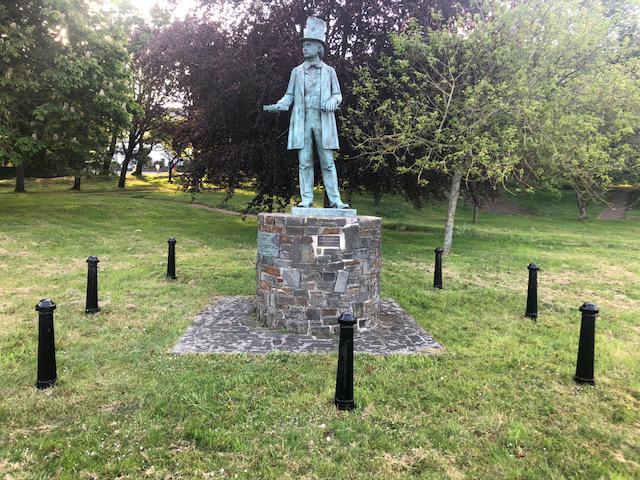Neyland is situated on the northern bank of the River Cleddau in Pembrokeshire and has a vibrant community of around 3000 residents. It’s a friendly place which grew up around the coming of the railway back in the 1850’s - its origins can be traced back precisely to Tuesday 15th April 1856, when the South Wales Railway (which reached Haverfordwest in December 1853), officially opened at Neyland. Neyland is now a very friendly, modern town with a beautiful Marina and its own Yacht Club. It is twinned with Sanguinet in France.
The original insignificant village of Neyland, sometimes rendered as `Nayland`, had in 1851, rather fewer than 200 inhabitants. The village, on the northern bank of Milford Haven, once had a Salt Refinery and a Shipyard and in the mid nineteenth century consisted of cottages, two chapels and two public houses. Most of the buildings were levelled by the Railway Company between 1855/1856. Once the railway opened, an entirely new Neyland grew up, near to the all important railway. The choice of Neyland as the terminus of the railway was entirely that of Isambard Kingdom Brunel ~(1806-1859). It is therefore highly appropriate that he is regarded as the founder of Neyland Town.
The opening of the railway was followed by a complete transformation of the Eastern part of Llanstadwell Parish. It was a period of tremendous growth. New houses sprang up for the railway workers, a Steamship service commenced in August 1856 to Waterford, and later to Cork in Ireland, operated by Messrs. Ford & Jackson.
A huge pontoon, designed by Brunel was launched in the spring of 1857 to facilitate the transport of passengers and livestock to and from Ireland. In 1858, a Steamship route from Neyland to Portugal and Brazil was inaugurated and in the same year the railway company decreed that henceforth, Neyland would be known as New Milford. The name existed alongside that of Neyland until it was officially discarded in August 1906.
Neyland was a true railway boomtown. The population of Llanstadwell Parish increased dramatically to one thousand and forty five people in 1861 and an impressive hotel, the South Wales Hotel, opened in 1858. The Picton Castle and Lawrenny Estates, which chiefly comprised Neyland, granted numerous leases for house building. Four new chapels and shops were added and new services and conveniences appeared. Neyland acquired an importance and status, which the inhabitants of the sleepy little village could never have dreamed of.
A golden period lasted for fifty years, to which numerous important figures contributed. These figures included Captain Thomas Jackson, Steamship owner: James Gaddarn, Shipbuilder, the Rev L.H. Rumsey M.A Vicar of Llanstadwell (1873-1911): Frederick Lloyd Hall, postmaster: John Henry Coram (1847-1907) and Mr F.W. P. Hitchings, to name but a few. Many Neyland men were employed by the railway and the Mackerel Season which was also very important. The Royal Dockyard at Pembroke Dock employed many Neyland Shipwrights, whilst the Great Western Railway had a factory at Neyland which at one time employed around 200 men. Local Government in the form of Llanstadwell Parish Council came in 1894 and six years later, in October 1900, Neyland obtained Urban District status.
A severe reverse came in August 1906, when the invaluable Irish traffic was transferred from Neyland north to Fishguard. The town was badly hit economically and its confidence shaken, but the towns-people showed commendable spirit and determination to protect the interests of their town. On November 16th 1908 a Neyland Fish Industry was inaugurated when an Ice Factory and Fish Market were opened. The same year saw street lighting introduced to the town. The period before the First World War saw other important improvements – the construction of the Promenade, construction of Church Lakes Bridge (1911) and the publication in 1913 of the first Town Guide. Numerous men from Neyland served in all branches of the armed forces during the First World War and a Monument to the fallen was unveiled in December 1930.
The inter war years were very difficult, especially with the closure of the Dock Yard at Pembroke Dock in 1926.
The arrival of the Royal Air Force at Pembroke Dock and the outbreak of the Second World War brought renewed activity to Neyland and the post Second World War period saw a considerable amount of house building, especially that undertaken by Neyland Urban District Council.
Neyland acquired a Technical Collage in the 1950`s but the following years brought fresh blows to the town. As part of the Beeching Cuts, Neyland lost its 108 year old railway, despite a heroic campaign to keep it open: the last train left the station in June 1964. In March 1975, a decade later, with the opening of the Cleddau Bridge, the Neyland to Hobbs Point Ferry ran for the last time.
This important route had a considerable history in itself, being established far back in 1858. Another familiar link with the past was irrevocably broken.
The last decade or so has seen a considerable change in the fortunes of Neyland. In 1985 work started on a Marina in Westfield Pill which now has placed Neyland firmly on the yachting map. Considerable sums have been spent on improving property in the town and there has been much new building at Honeyborough.
The population has risen appreciably and with new shops and services being established and in recent years there is revived confidence and optimism. Since 1988 the Brunel Festival Association has organized a week of community events, whilst the Brunel Memorial Fund has been successful in raising sufficient funds to erect a bronze statue to Isambard Kingdom Brunel, in July 1999.
The Cricket, Rugby Football and Association Football teams in Neyland maintain the proud tradition of sporting success.
Neyland has certainly suffered varying degrees of good and ill luck over the years, enduring boom and bust, triumph and adversity, but the town has come through it all. Neyland clearly has a fascinating social history which at last is now being appreciated.

